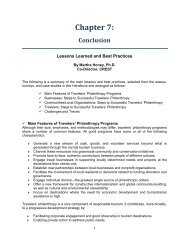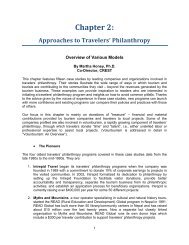Travelers' Philanthropy Handbook - Center for Responsible Travel
Travelers' Philanthropy Handbook - Center for Responsible Travel
Travelers' Philanthropy Handbook - Center for Responsible Travel
You also want an ePaper? Increase the reach of your titles
YUMPU automatically turns print PDFs into web optimized ePapers that Google loves.
have a positive impact on climate change through carbon sequestration, as well as reducedlevels of erosion of organic material into the nearby river.When the Bushbuck was introduced in the description of the project, the idea of CO2 anderosion becomes even more compelling and appealing – in most cases this is why peoplechose to give. Technically, the project is important enough to interest large-scale fundingmechanisms through programs such as REDD (Reduced Emissions from De<strong>for</strong>estation andDegradation). But it is unlikely that small to intermediate travel donors would be as attracted tothe REDD argument as much as to the Bushbuck story – after all they are travelingphilanthropists on safari!Posted on the web and carried in the local paper, this project becomes an example of howcommunication may take place in a relatively simple way be<strong>for</strong>e a donor has decided to supportit. On top of that, an invitation from a lodge or tour operator to take guests see the project andparticipate in planting trees to offset the carbon emissions from overseas flights might just takeaway any of the remaining doubts – seeing is believing!To honor the complexity surrounding the planting of trees and off-setting flight carbon, some indepthexplanation on how theproject is structure d to deal withsequestration rapidly becomesnecessary and must beprovided as donors express realinterest in participating. Keepthe threshold low in thebeginning of communicationand let the donor decide on thelevel, but be proactive andprepare well in advance to beable to supply criticalin<strong>for</strong>mation surrounding theproject.One of the more crucialobstacles to giving is “how” youMara Bushbuck campsite, Kenya. Credit: Basecamp Foundationgive. What is the actualpayment structure that a project uses? At Basecamp we offer to give “where you are,” meaningthat you can give directly at the actual destination where the project takes place or you canexecute a payment through one of our foundations registered in Norway, Kenya, India, and theUnited States. Regardless of where the donation is physically transacted, it always loops backthrough the “Mother” Foundation in Norway. This is to keep absolute control on the flow ofdonations -- “follow the money.” This structure was chosen to provide transparency as well astax benefits, whenever applicable. Basecamp Foundation Kenya is the principal “spending” armresponsible <strong>for</strong> reimbursing project costs and reporting back to the donors. In this way, it ispossible <strong>for</strong> the donor to follow the money from where it was donated, through the “Mother”Foundation’ accounting procedure, into the individual project and back to the donor.As you report back on projects try to use all available means including newsletters, photos, weband social media. It is seldom the case that we over-communicate, but rather the opposite.Much of the communication can take a “light” <strong>for</strong>m as described in the next section, but there isalso a clear need <strong>for</strong> more “weight” in the communication through third party confirmation,132















